MHI, Mitsubishi Power Report Breakthroughs for Hydrogen Combustion, Ammonia Burners
Mitsubishi Power has successfully demonstrated partial load and full load combustion of a fuel blend with 30% hydrogen (by volume) in a grid-connected J-series Air-Cooled (JAC) gas turbine. The achievement closely follows the completion of a combustion test on an ammonia single-fuel burner for coal firing by Mitsubishi Heavy Industries (MHI), Mitsubishi Power’s parent company.
The technological breakthroughs represent pivotal advancements for MHI, which has been working to “future-proof” its legacy thermal power generation business and provide highly efficient and environmentally friendly energy generation options for customers through fuel flexibility, including low-carbon fuels like hydrogen and ammonia.
Under MHI’s “MISSION NET ZERO” strategy, which aims to achieve carbon neutrality for its businesses and customers by 2040, the company is spearheading the validation and commercialization of various combustors for hydrogen co-firing, single-fuel hydrogen firing, and single-fuel ammonia firing. It is also developing technologies “to meet a wide range of ammonia usage needs,” from low-ratio to high-ratio co-firing in utility and industrial boilers.
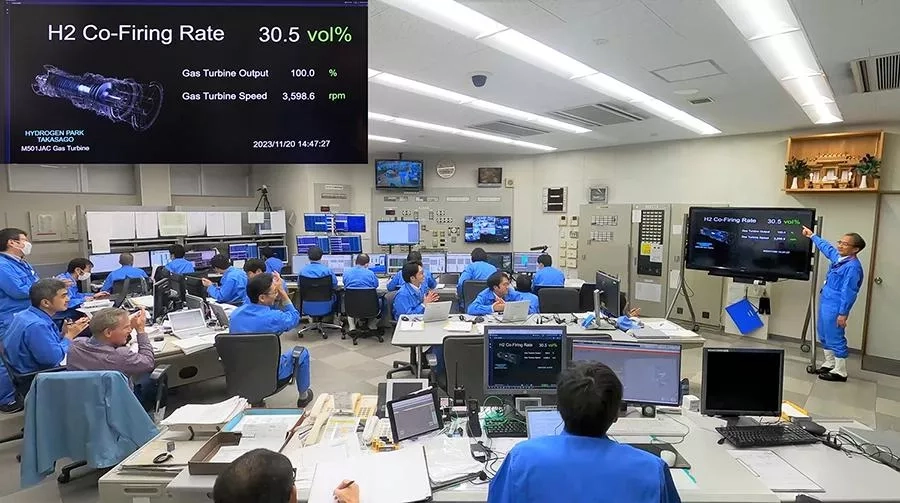
A Big Step for an Integrated, Grid-Connected System
Mitsubishi Power’s hydrogen co-firing combustion demonstration, announced on Nov. 30, is notably “the world’s first power generation test on a large frame gas turbine using a fuel mixture of 30% hydrogen while connected to the local power grid and using hydrogen produced and stored on the same site,” the company said.
The testing was conducted at T-Point 2 Combined Cycle Power Plant Validation Facility, Mitsubishi Power’s dedicated gas turbine demonstration and validation facility that uniquely won POWER’s Plant of the Year award in 2020. T-Point 2 comprises a next-generation M501JAC gas turbine with a rated output of 566 MW (at 60 Hz) that was grid-connected in 2020. Along with an enhanced air-cooled system for cooling the combustor, the facility’s JAC turbine has a turbine inlet temperature of 1,650C and includes a thicker thermal barrier coating (TBC) and a compressor with a high-pressure ratio.
T-Point 2 is housed at Takasago Hydrogen Park, an integrated hydrogen validation facility within MHI’s Takasago Machinery Works in Hyogo Prefecture, west-central Japan. The integrated hydrogen facility began full-scale operation in September 2023.
Takasago Hydrogen Park also includes a 5.5-MW alkaline electrolyzer, manufactured by HydrogenPro AS of Norway, that has a hydrogen production capacity of 1,100Nm3/h, one of the highest in the world. The facility’s produced hydrogen is stored in storage equipment with a capacity of about 39,000 Nm3. Future plans call for testing and validating next-generation hydrogen production technologies such as high-temperature steam electrolysis using solid oxide electrolysis cells (SOEC), integrated validation of “turquoise” hydrogen production, its storage, and power generation in addition to hydrogen production using the alkaline water electrolyzer.
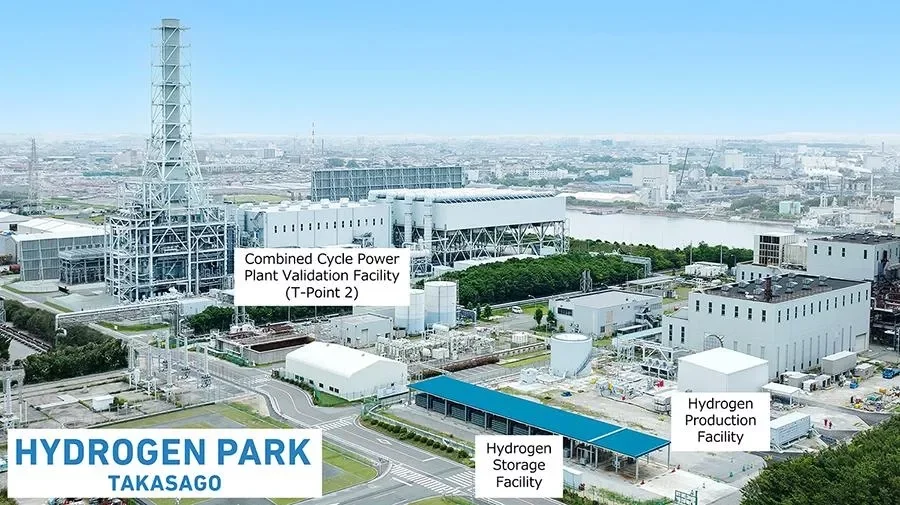
A Two-Part Demonstration
The successful demonstration unveiled on Thursday entailed two parts, Mitsubishi Power said: It “executed a fuel blend of 30% hydrogen by volume,” utilizing hydrogen produced at Takasago Hydrogen Park; and it demonstrated the utilization of that fuel in T-Point 2’s M501JAC turbine at partial load and full load.
A key demonstration focus has been to verify a dry-low NOx (DLN) pre-mixed multi-nozzle combustor technology, which addresses flashback (backfire), combustion pressure fluctuation, and nitrogen oxide (NOx) emissions. Developed with funding by Japan’s New Energy and Industrial Technology Development Organization (NEDO), Mitsubishi Power in 2018 validated the use of 30% hydrogen by volume in the large frame gas turbine combustor, and in 2022, it validated 50% hydrogen by volume.
However, the integral demonstration unveiled on Thursday “verified the achievement of the same low NOx emissions and stable combustion during hydrogen co-firing, and that switching fuels from natural gas to hydrogen fuel blending is possible during partial-load and full-load operation,” the company said. In 2024, the company plans to “proceed with the expansion of the hydrogen storage facility and perform a demonstration using a 50% hydrogen blended fuel.”
To get to a 100% hydrogen capability, the company has, in tandem, been developing a single-fuel “multi-cluster” combustor technology that enables efficient mixing of hydrogen and air via an upgraded fuel delivery nozzle design. Hydrogen co-firing using the novel combustor at a 1,300C-class gas turbine is underway at J-POWER’s Osaki Cool Gen project, a 2017-completed integrated gasification combined cycle (IGCC) plant in Hiroshima Prefecture.
Mitsubishi Power’s development of a 1,650C-class multi-cluster combustor is also underway. Combustion tests are slated in 2025, and the company is eyeing commercialization by 2030, “when hydrogen is expected to be in sufficient supply.”
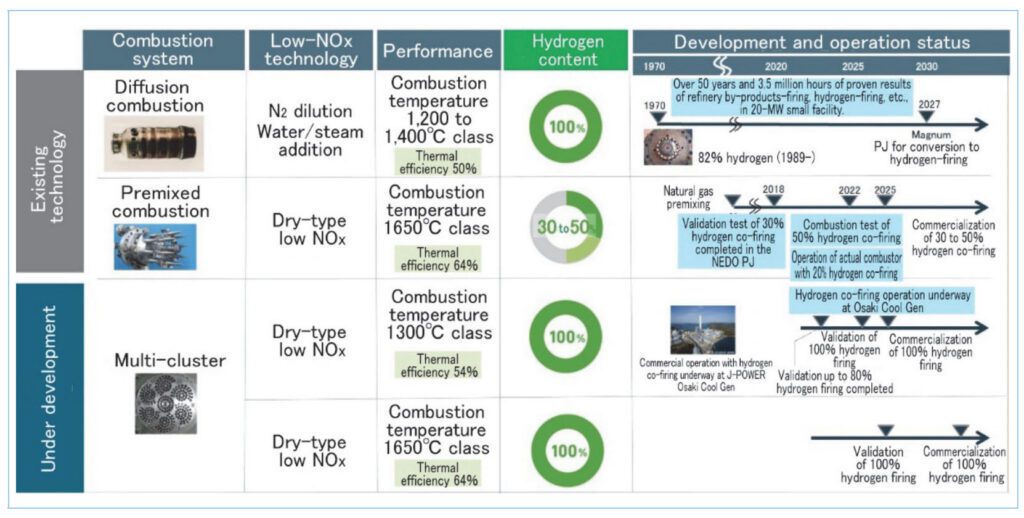
T-Point 2, notably, also includes a small- and mid-sized (40-MW class) H-25 gas turbine, which Mitsubishi Power had previously installed for compressor driving at the combustion test facility. Validation of 100% hydrogen firing in the H-25 gas turbine, which will use the company’s Type 3 Multi-Cluster combustor, is planned for 2024, the company said on Thursday.
Commercialization of Mitsubishi Power’s hydrogen capabilities will be on full display at the Advanced Clean Energy Storage Project in Delta, Utah. The 300-GWh integrated hydrogen system that is shaping up to be the largest renewable hydrogen energy hub in the U.S. envisions producing up to 100 metric tonnes per day of hydrogen from water and renewable energy sources using a HydrogenPro 220-MW high-pressure alkaline electrolyzer bank. It will store that hydrogen in two gigantic solution-mined caverns sited in the only salt dome in the Western U.S and then provide that hydrogen to two M501JAC gas turbines, which Mitsubishi Power recently delivered to the 840-MW IPP Renewed project.
The two turbines will be capable of utilizing a fuel blend of 30% hydrogen by volume when they begin operation in 2025. Under a 20-year long-term service agreement (LTSA), Mitsubishi Power will incrementally increase the amount of hydrogen in the fuel mix as available from the adjacent ACES Delta project to achieve a 100% hydrogen combustion volume by 2045, catering to California’s stringent mandate for carbon-free power.
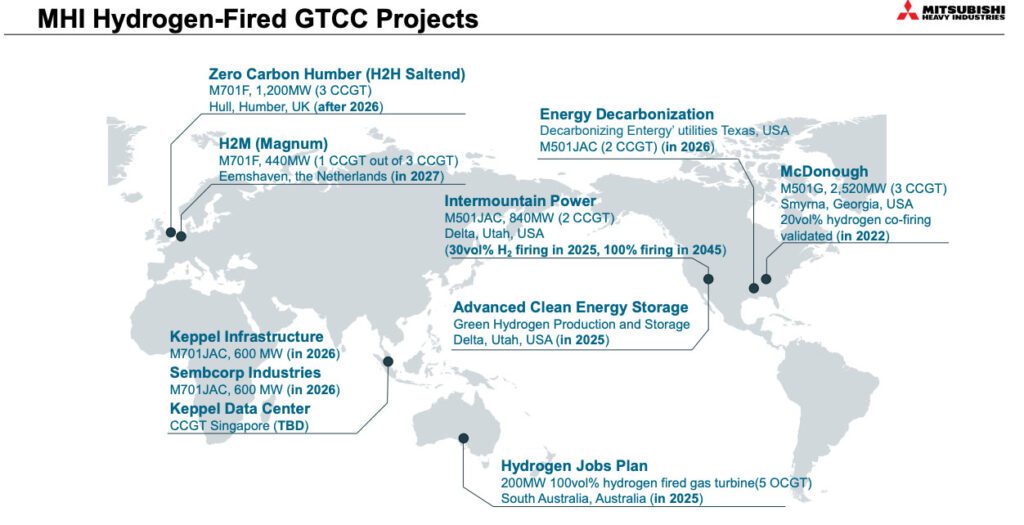
MHI Completes Ammonia Single-Fuel Burner Test for Coal Boilers
Meanwhile, MHI has since 2021 been developing a burner that enables high-ratio ammonia co-firing in pulverized coal-firing boilers as part of NEDO’s Fuel Ammonia Supply Chain Establishment project. A key project objective is to develop—by fiscal year 2024—burners capable of ammonia single-fuel firing for both circular firing–type and opposed firing–type burners through combustion tests “with a full-scale burner equivalent to actual equipment.”
On Tuesday, the company announced it successfully completed a combustion test of an ammonia single-fuel burner at its Nagasaki District Research & Innovation Center, a dedicated test facility in Nagasaki district, Japan.
“Utilizing a combustion test furnace with fuel consumption of 0.5 tons per hour (t/h), MHI conducted a single-fuel burner test using an ammonia burner and a high-ratio ammonia co-firing test with coal,” the company said. “In both cases, the tests confirmed stable combustion, reduced NOx emissions compared to coal firing, and complete combustion of the ammonia.”
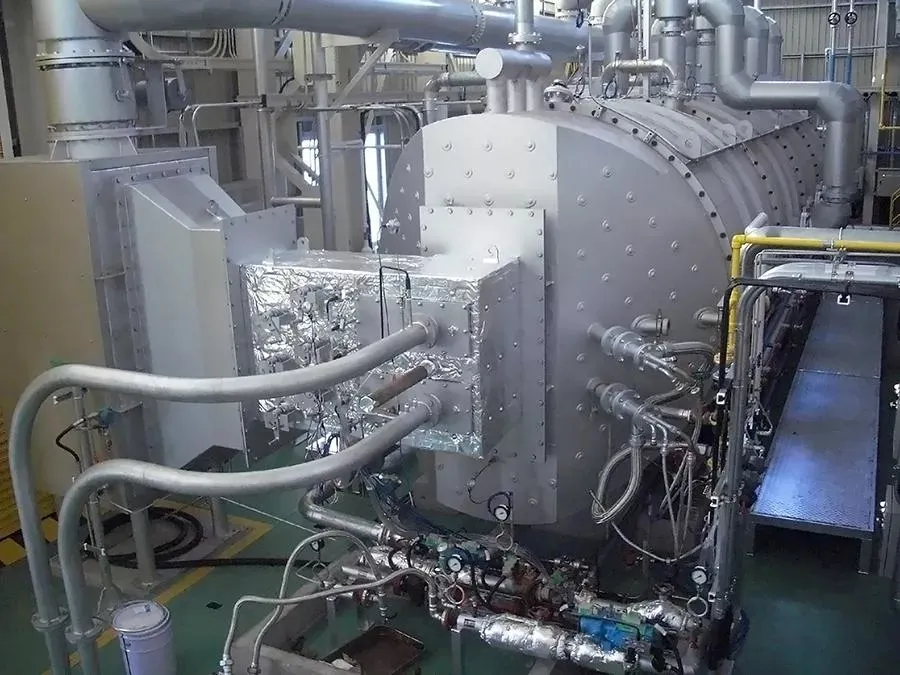
Next, MHI plans to conduct a combustion test using an actual-sized burner in “a larger 4t/h combustion test furnace.” Based on that test, MHI will then “take steps for application of the burner it has developed for thermal power plants in Japan and overseas,” it said.
MHI, notably, is working with Japanese power generator JERA on the project. In 2022, the companies said they planned to “draw up a master plan for equipment to demonstrate its use in actual boilers.” The two companies are expected to decide whether to install the burners at JERA’s coal-fired boilers made by MHI. “For the actual plant demonstrations, JERA and MHI plan to verify co-firing with at least 50% ammonia at two units with different boiler types by FY 2028,” they suggested.
JERA—a joint venture between Tokyo Electric Power Co. (TEPCO) and Chubu Electric that is looking to shift its massive coal-fired fleet to 100% ammonia by 2050—is already working to establish the technology and co-fire up to 20% ammonia at the 1-GW Unit 4 of JERA’s 4.1-GW Hekinan Thermal Power Station, beginning in fiscal year 2024. On Nov. 29, JERA President Hisahide Okuda told reporters the project is on track to begin in March 2024. Plans call for increasing ammonia co-firing to more than 50%, with an actual power plant demonstration in 2028/2029, and potentially the start of commercial operation in the early 2030s.
Earlier this year, JERA and MHI signed a memorandum of understanding (MOU) with Thailand’s Electricity Generating Public Company Ltd. to assess the feasibility of up to 20% ammonia co-firing at the 1.4-GW coal-fired BLCP power plant. JERA, meanwhile, has MOUs to study ammonia co-firing with Aboitiz Power, a coal generator in the Phillippines. MHI has a similar agreement with Chilean independent power producer Guacolda Energia, as well as several other entities.
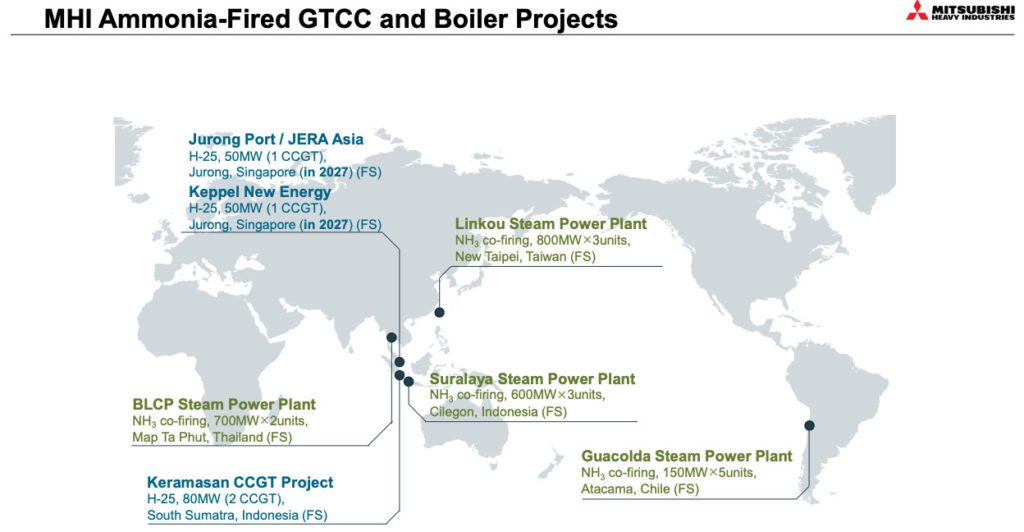
MHI Separately Exploring Opportunities for Ammonia Gas Combustion
MHI and JERA have joined forces to explore ammonia-firing in gas turbines, too. In August 2022, the two companies set out to jointly explore establishing a 100% ammonia-fired combined cycle plant on Jurong Island in Singapore. Under an MOU, the two entities will study establishing a 60-MW class gas turbine combined cycle plant.
Jurong Island, notably, has emerged as a hotspot for hydrogen and ammonia combustion activity. MHI is, in addition, fielding another potential opportunity with Singapore energy infrastructure developer Keppel Infrastructure and DNV for a 100% ammonia-fueled gas turbine or combined cycle system. And as POWER recently reported, Sembcorp Industries, GE Vernova, and Japanese heavy industry firm IHI Corp. are also jointly examining potentially retrofitting two GE 9F gas turbines at an 815-MW gas-fired combined cycle power plant in Singapore with ammonia capabilities.
MHI notes that it started development of a single-fuel ammonia combustor for gas turbine power generation in 2021. Mitsubishi Power, notably, is leading the charge to develop a 40-MW class gas turbine that can directly combust 100% ammonia.
The company is currently working out how to directly combust ammonia using a Type 1 diffusion combustor while removing NOx byproducts caused by oxidation resulting from the combustion of the nitrogen component of the fuel.
One solution, which is applied to the company’s H-25 gas turbine series, combines a gas turbine system with NOx removal equipment. Plans, for now, target possibly pairing an ammonia-fired combustor with an “ultra-high-performance denitration facility.” In tandem, the company is evaluating the use of waste heat from gas turbines in combined cycle systems to reconvert ammonia into hydrogen and nitrogen. An actual plant validation could occur in 2025, it suggests.
—Sonal Patel is a POWER senior associate editor (@sonalcpatel, @POWERmagazine).